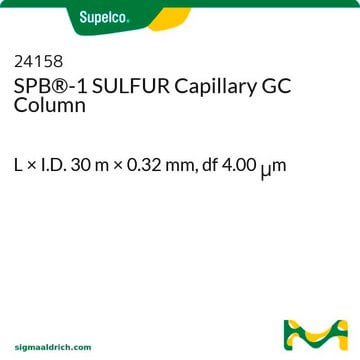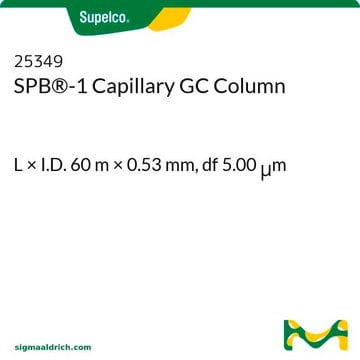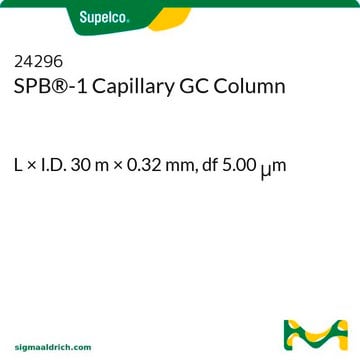24028
SPB®-1 Capillary GC Column
L × I.D. 30 m × 0.25 mm, df 0.25 μm
Autenticatiper visualizzare i prezzi riservati alla tua organizzazione & contrattuali
About This Item
Codice UNSPSC:
41115710
eCl@ss:
32119290
Prodotti consigliati
Materiali
fused silica
agenzia
meets requirements for USP G1, G2, and G9
Parametri
-60-320 °C temperature (isothermal or programmed)
Beta
250
df
0.25 μm
tecniche
gas chromatography (GC): suitable
Lungh. × D.I.
30 m × 0.25 mm
Gruppo funzionale matrice
Bonded; poly(dimethyl siloxane) phase
Tipo di colonna
capillary non-polar
Cerchi prodotti simili? Visita Guida al confronto tra prodotti
Descrizione generale
Application: This column is often used for traditional general purpose applications, where a non-polar column is required. Analytes will be separated primarily according to boiling point.
USP Code: This column meets USP G1, G2, and G9 requirements.
Phase:
USP Code: This column meets USP G1, G2, and G9 requirements.
Phase:
- Bonded
- Poly(dimethyl siloxane)
- ≤0.32 mm I.D., <2 μm: -60 °C to 320 °C (isothermal or programmed)
- ≤0.32 mm I.D., ≥2 μm: -60 °C to 300 °C (isothermal or programmed)
- ≥0.53 mm I.D., <2 μm: -60 °C to 300 °C (isothermal) or 320 °C (programmed)
- ≥0.53 mm I.D., ≥2 μm: -60 °C to 260 °C (isothermal) or 280 °C (programmed)
Applicazioni
SPB®-1 Capillary GC Column was used for speciation of the nitrogen compounds (quantitatively), which are polar and somewhat basic in nature, with chemiluminescence detection.
Altre note
We offer a variety of chromatography accessories including analytical syringes
Note legali
SPB is a registered trademark of Merck KGaA, Darmstadt, Germany
Codice della classe di stoccaggio
10 - Combustible liquids
Classe di pericolosità dell'acqua (WGK)
WGK 1
Punto d’infiammabilità (°F)
214.0 °F - closed cup
Punto d’infiammabilità (°C)
101.1 °C - closed cup
Choose from one of the most recent versions:
Possiedi già questo prodotto?
I documenti relativi ai prodotti acquistati recentemente sono disponibili nell’Archivio dei documenti.
I clienti hanno visto anche
H Seno et al.
Forensic science international, 50(2), 239-253 (1991-09-01)
The positive ion electron impact (PIEI), positive ion chemical ionization (PICI) and negative ion chemical ionization (NICI) mass spectra and a rapid isolation procedure using Sep-Pak C18 cartridges are presented for ten local anaesthetics. In the PIEI mode, molecular peaks
K Shindo et al.
Drugs under experimental and clinical research, 17(7), 343-349 (1991-01-01)
To confirm that platelet activating factor (PAF) plays an important role as a mediator in acute inflammation and allergic reaction, it is necessary to develop a more sensitive and stable method for measuring trace amounts of PAF in various biological
A M Roccamo et al.
The European journal of neuroscience, 11(5), 1615-1623 (1999-04-24)
The properties of the nicotinic acetylcholine receptor (AChR) are modulated by its lipid microenvironment. Studies of such modulation are hampered by the cell's homeostatic mechanisms that impede sustained modification of membrane lipid composition. We have devised a novel strategy to
P J Streete et al.
The Analyst, 117(7), 1111-1127 (1992-07-01)
Headspace gas chromatography with split flame-ionization-electron-capture detection is a simple method of screening for a wide range of volatile substances in biological fluids. A 60 m x 0.53 mm i.d. thick-film (5 microns) fused-silica capillary coated with SPB-1 (Supelchem) with
A Paraneeiswaran et al.
Chemosphere, 95, 503-510 (2013-11-05)
In this study, a promising bioremediation approach was developed to remove [Co(III)-EDTA](-) complex that is generated during the waste management process. Though several studies have been reported on bioremediation of cobalt, the removal of [Co(III)-EDTA](-) complex has not been tested.
Il team dei nostri ricercatori vanta grande esperienza in tutte le aree della ricerca quali Life Science, scienza dei materiali, sintesi chimica, cromatografia, discipline analitiche, ecc..
Contatta l'Assistenza Tecnica.






